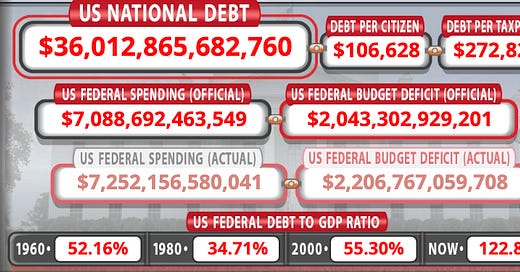Last week, amid the post-election frenzy, a critical milestone slipped by almost unnoticed: U.S. government debt surged past $36 trillion.
Let that number sink in for a moment. In just twelve months, the debt has exploded by $2.9 trillion. That's $8 billion of new debt every day, $331 million each hour, and $5.5 million every minute.
Here’s a link if you want to watch it tick up live by the second, though I warn you—it's not for the faint of heart.
In short, America's finances aren't just shaky—they're coming apart at the seams.
If you've been following us for a while, this might not come as a surprise. Doug Casey has been sounding the alarm about the dangerous levels of U.S. debt for decades. Yet, mainstream media and the expert class have largely brushed it off, leaving Americans in the dark about the true extent of the crisis.
Well, it looks like that reality is getting harder to ignore now...
When Reality Crashes the Party
Treasury Secretary Janet Yellen recently went to the World Bank and IMF annual meeting, but before she could get in her Trump-bashing talking points, she got ambushed by journalists with questions about how she planned to convince other nations to continue buying U.S. government debt—given the already massive national debt and out-of-control deficits.
Most of what came out of her mouth was the usual nonsense about "staying on a sound fiscal path" and other meaningless phrases. But then she said something interesting, and I quote:
I believe it’s very important that we remain focused on keeping the real net interest cost of the debt near historic levels and certainly under 2% (of GDP).
Oh, really? How's that been working out, Dear Janet?
The latest figures were published just days ago, and they showed (see “Table 3”) that net interest payments hit $949 billion for this fiscal year through September. That's about $2.6 billion every single day.
Note: “Net interest” is the interest paid on U.S. Treasury debt held by the public, including both domestic and foreign sources.
Now, I'm focusing on net interest payments here because that’s what Yellen talked about. The gross figure, mind you, sits at about $1.2 trillion.
But even this adjusted $949 billion figure already makes up 3.3% of America's GDP – something we haven't seen in decades.
To put this in perspective: that’s more than the annual spending on Medicare ($870 billion) and dwarfs Medicaid ($618 billion). It’s also more than triple what the government spends on veterans’ affairs ($325 billion). In fact, you could combine spending on the Department of Education ($268 billion), Veterans’ Affairs, and the entire military budget—and interest payments would still be greater.
So when Yellen makes statements like this, she's basically admitting what we've known all along: Interest payments are bankrupting the government, plain and simple.
The Trust Problem
Now, I'll talk more about our government's interest costs and possible escape routes later this week, but let's analyze for a second why Yellen is talking about this at all. Why is she engaging with other countries on managing sovereign debt?
Well, that's because those nations aren't stupid. They can see U.S. deficits and debt levels are spiraling out of control, and they want assurances.
Yellen, thick though she may be, realizes she can't just bank on foreigners to keep buying U.S. debt, especially as more of them start distancing themselves from the dollar.
At writing, foreign nations hold about $8.7 trillion of U.S. federal debt — and that doesn’t include the many trillions of additional agency debt they also hold.
For many of these countries, it’s not necessarily about de-dollarization—it’s about prudent fiscal management.
Just think about this from a foreigner's point of view: Would you keep trusting a country that's so irresponsible with its finances to hold the bulk of your reserves?
Keep in mind that just last year, two of the Big Three credit agencies, Moody’s and Fitch, downgraded their outlook on U.S. debt. One of the main reasons they cited for the downgrade was, you guessed it, surging interest payments.
And that was before the U.S. government added another $2.9 trillion in debt. Keep in mind, Fitch also downgraded the U.S. long-term foreign currency issuer default rating back in August of this year.
The point is, you can see where the foreigners’ concern is coming from—and it’s a problem for America.
If they lose faith in the U.S. government’s $36 trillion pile of debt, yes, interest costs will skyrocket—hard as it is to imagine, given the already insane levels. But something else will happen too. Here’s Doug Casey, eloquently explaining it better than I ever could.
Doug Casey: Our main export has been dollars. So, now there are tens of trillions of dollars that are outside the U.S. owned by non-Americans, that don't have to own those dollars. And when they get scared enough of those dollars, they will dump them. And when they can't dump them to each other anymore at lower values, those dollars will come back to the U.S. where they'll buy stuff that Americans now own. Like titles to stocks and real estate and so forth. So, the average American is in for a very rude awakening in the next few years.
Regards,
Lau Vegys




I must say Lau Vegys writes very well to my way of reading and it was a pleasure to read his post.
Thank you chaps!
☘
💖🙏💫
- GOT ANY ANSWERS ..???